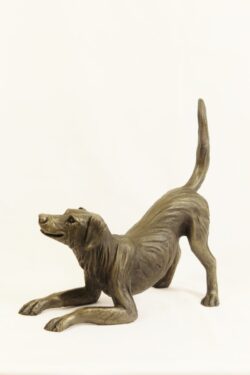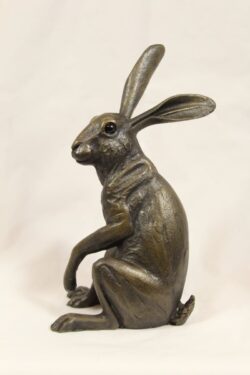Description
Hedgehog on apple
Hedgehogs feed mostly on insects, but sometimes they will eat fallen fruit, possibly they are after the grubs in it. Then again perhaps he’s just trying to get a better look. Don’t worry though, you won’t have to feed my bronze resin Hedgehog on apple, large, he’ll mostly look after himself.
Hedgehogs
If you had never seen a hedgehog before, you would think it was a most unusual animal, unlike anything else in this country. My neighbour helps with rescuing them, so I have been very lucky to see tiny baby ones. One night I was lying in bed and heard some peculiar noises below the bedroom window, I couldn’t work out what it was and went to investigate, to find two hedgehogs were courting amongst the plant pots on the patio!
I really enjoyed making the originals for the resin sculptures
If you need advice about a hedgehog which needs help, contact the British Hedgehog Preservation Society
British hedgehogs are in trouble, to help them, donate to a hedgehog charity or join the Wildlife Trust in your area
Hedgehogs are nocturnal and only come out at night. They are covered with a coat of very sharp spines, which are hollow and make of keratin (like your fingernails). Hedgehogs can roll into a ball and the spines will protect them from predators, except badgers and the occasional dog.
During the day, and during winter hibernation, the hedgehog will sleep in a specially built nest in thick undergrowth, under a shed, in piles of leaves or unlit bonfires. It will never sleep or hibernate outside a nest.
Hedgehogs are insectivores that eat all manner of garden invertebrates from beetles, millipedes and worms to slugs and snails, caterpillars, earwigs and millipedes. As well as these, they also eat a wide range of other insects, and more infrequently will take advantage of carrion, frogs, baby rodents, baby birds, birds’ eggs and fallen fruit.
They are found across most of Western Europe and also in New Zealand! where they introduced in the nineteenth century. They live in woodland, meadows, grassland, orchards, vineyards, farmland, parks and gardens, including those in urban areas.
Young hedgehogs are called Urchins. Typical litter is 4 to 6 babies, but can have around 10. Normally born early to late summer, although the late born babies will struggle to put on the weight needed for hibernation.
The male hedgehog takes no part in rearing baby hedgehogs. They are born after a 35 day pregnancy. The mother will have made a maternity nest as a nursery. This can be under a hedge, in a pile of leaves, or very often under a shed or outbuilding.
The urchins are born with their first spines, which are white, covered by skin. As soon as they are born, the spines start to come through. Normally, they only have one litter a year. At birth the baby urchins’ eyes and ears are closed. These open at about 14 days and their teeth start to come through after 21 days. After 8 weeks they are ready to become independent.
An urchin outside a nest is going to need rescuing. Its distress call is a high piping sound. It is no good putting stray urchins back into a nest or with other hedgehogs, they will get eaten. If you uncover a nest with urchins in it, do not disturb it, but cover it over again and leave it. The mother will usually return but not if human scent is on the babies.
To find out more why not try The British Hedgehog Preservation Society





